Factory Acts Worksheets
Do you want to save dozens of hours in time? Get your evenings and weekends back? Be able to teach about the Factory Acts to your students?
Our worksheet bundle includes a fact file and printable worksheets and student activities. Perfect for both the classroom and homeschooling!
Resource Examples
Click any of the example images below to view a larger version.
Fact File
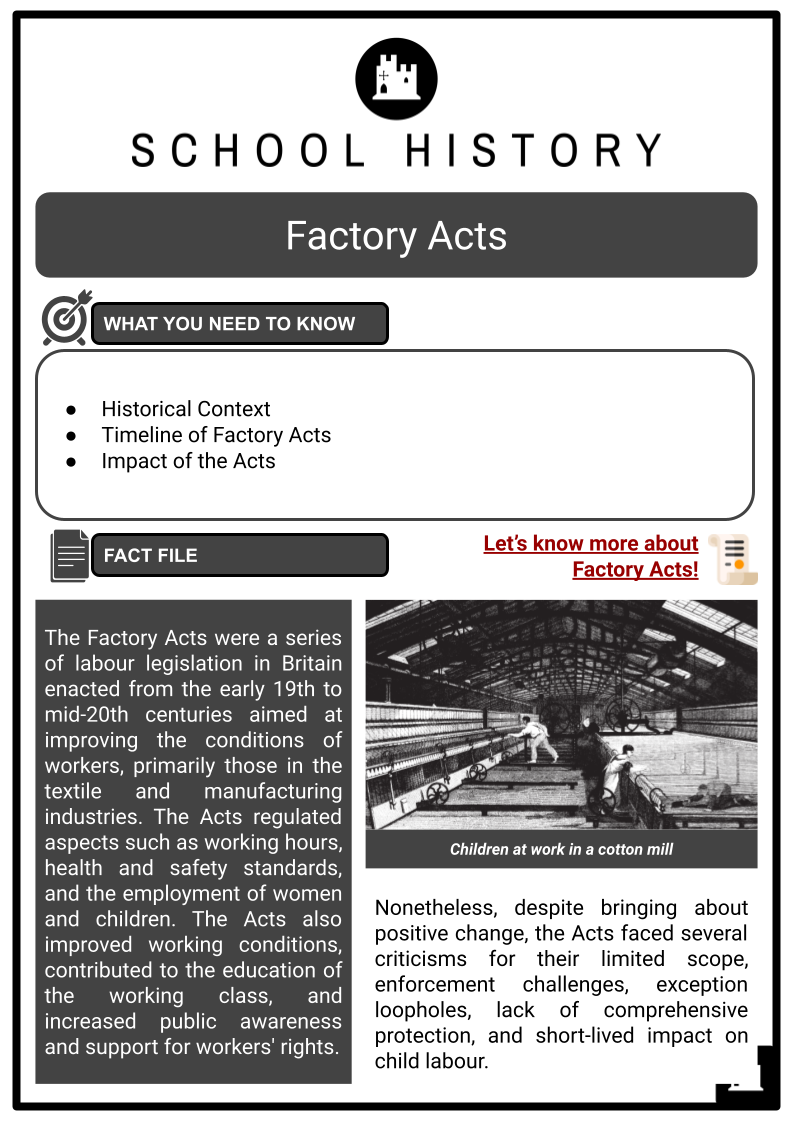
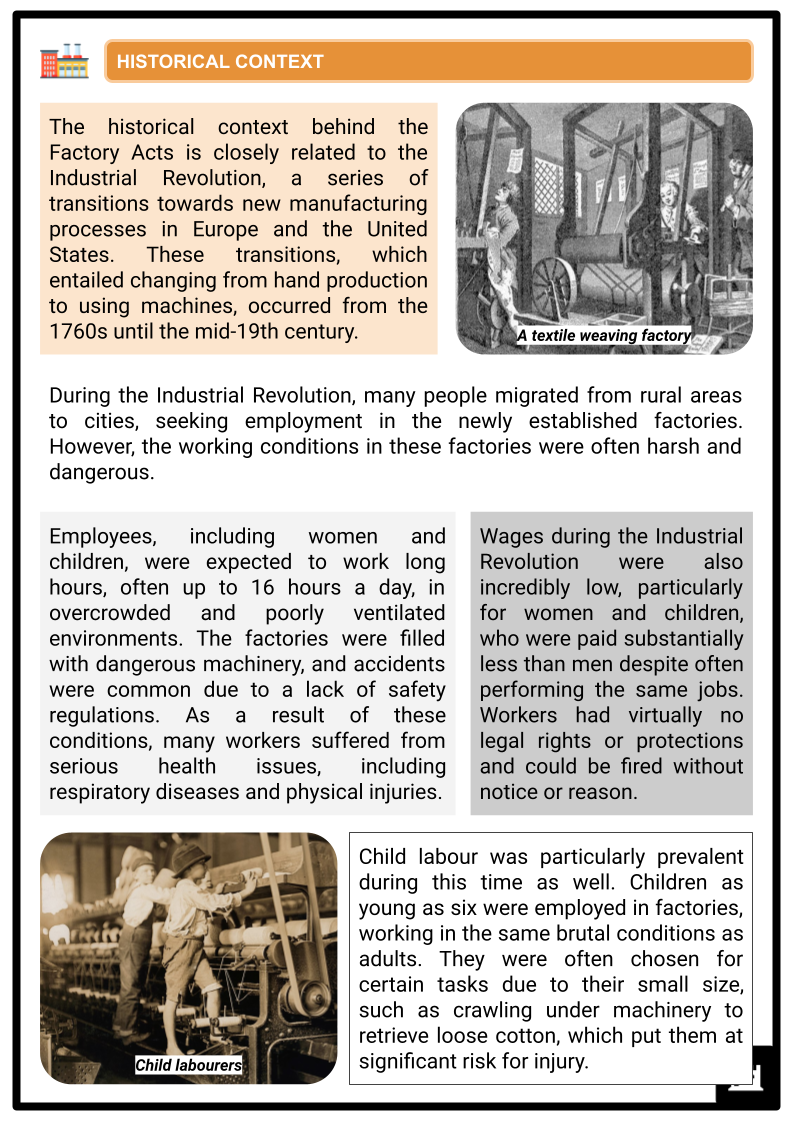
Student Activities
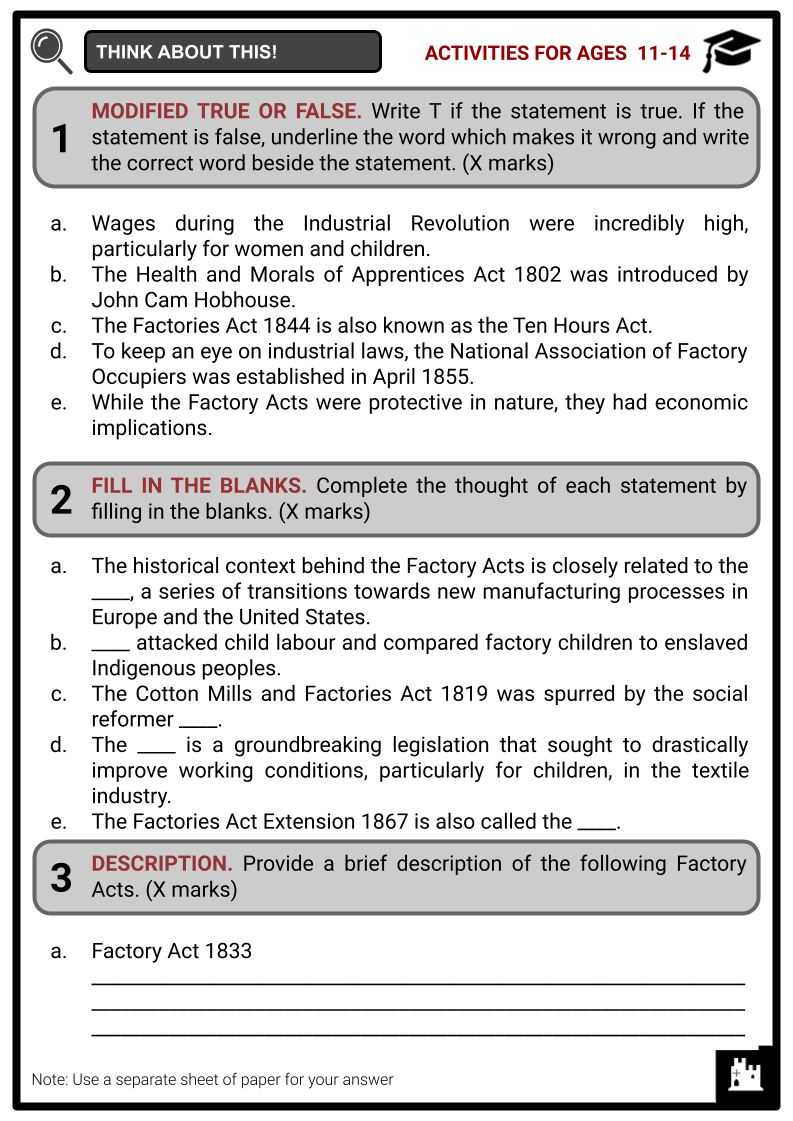
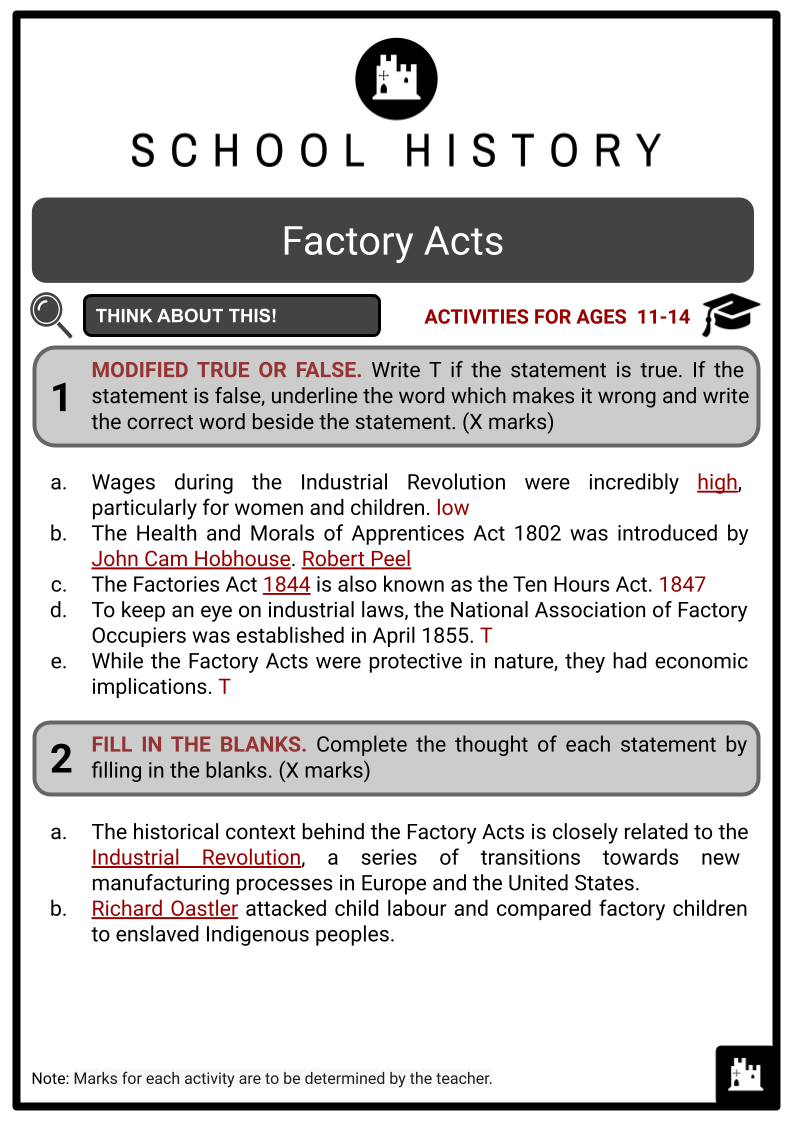
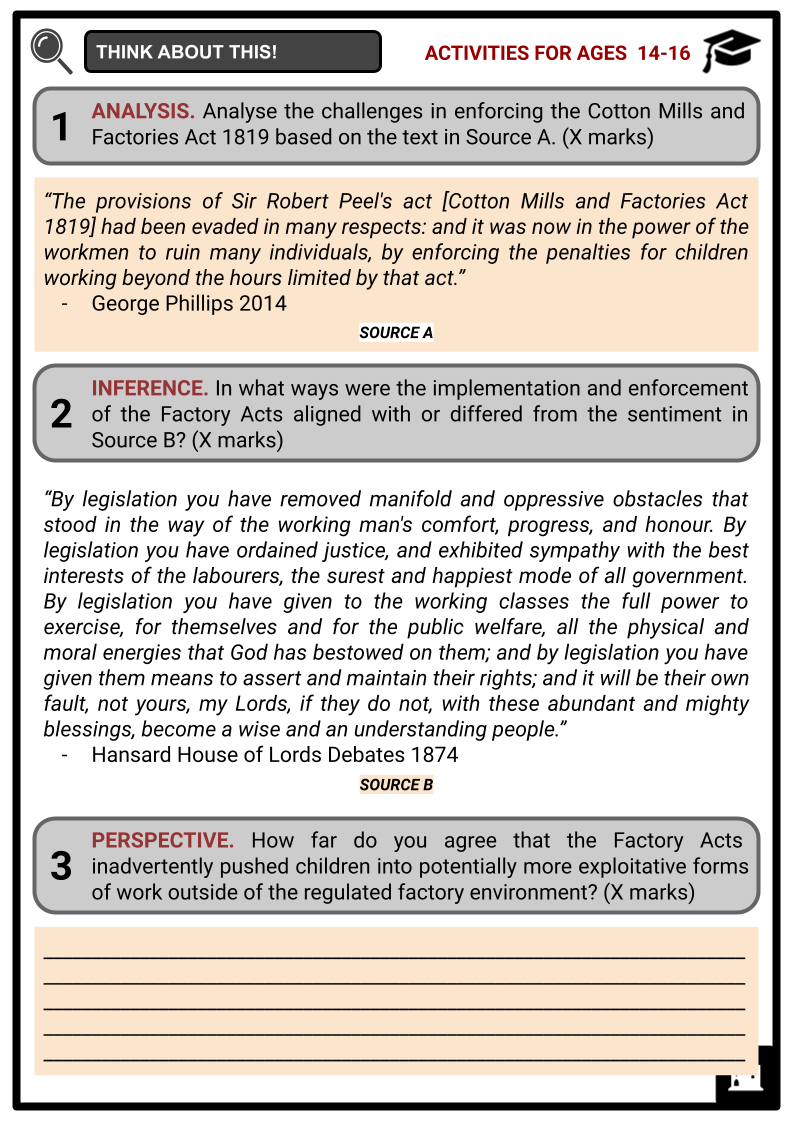
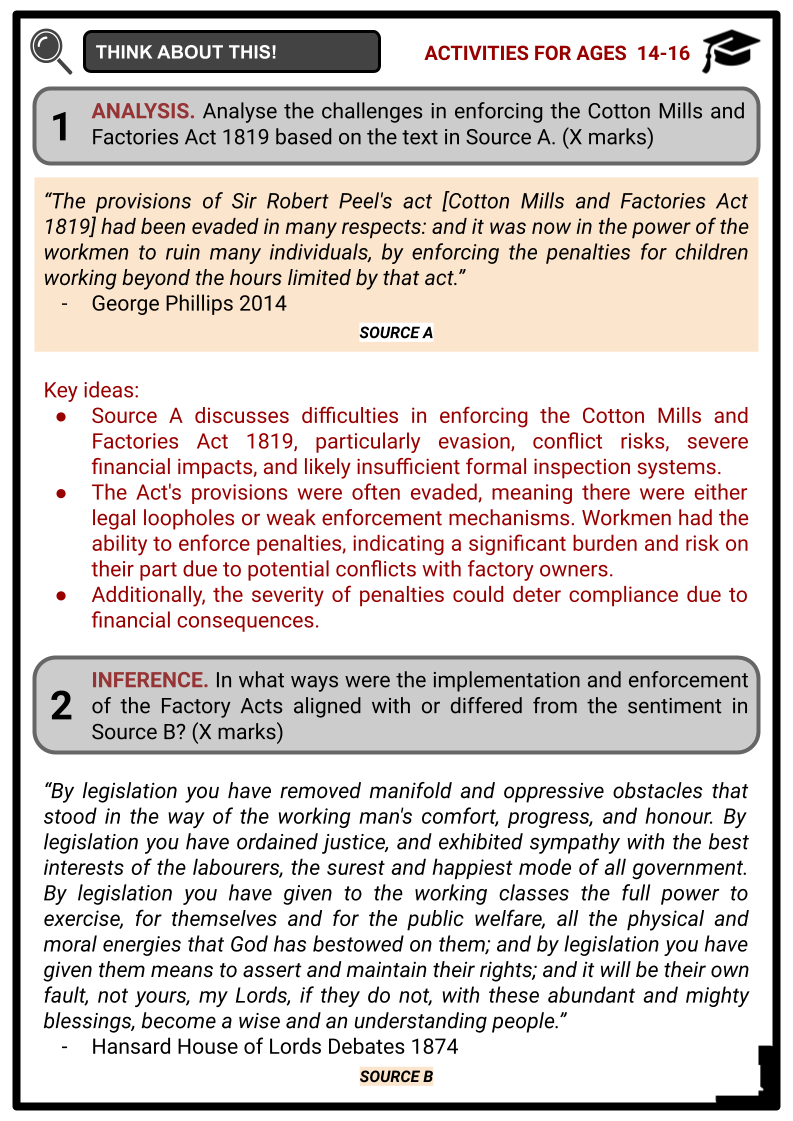
Summary
- Historical Context
- Timeline of Factory Acts
- Impact of the Acts
Key Facts And Information
Let’s know more about Factory Acts!
The Factory Acts were a series of labour legislation in Britain enacted from the early 19th to mid-20th centuries aimed at improving the conditions of workers, primarily those in the textile and manufacturing industries. The Acts regulated aspects such as working hours, health and safety standards, and the employment of women and children. The Acts also improved working conditions, contributed to the education of the working class, and increased public awareness and support for workers' rights.
Nonetheless, despite bringing about positive change, the Acts faced several criticisms for their limited scope, enforcement challenges, exception loopholes, lack of comprehensive protection, and short-lived impact on child labour.
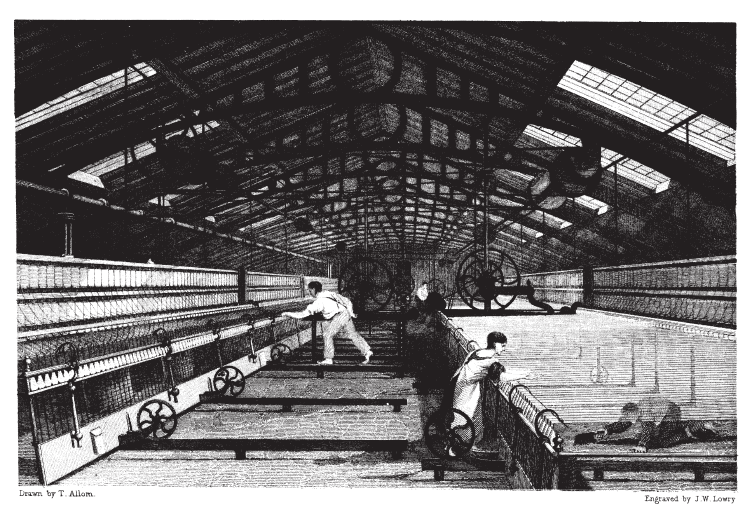
HISTORICAL CONTEXT
- The historical context behind the Factory Acts is closely related to the Industrial Revolution, a series of transitions towards new manufacturing processes in Europe and the United States. These transitions, which entailed changing from hand production to using machines, occurred from the 1760s until the mid-19th century.
- During the Industrial Revolution, many people migrated from rural areas to cities, seeking employment in the newly established factories. However, the working conditions in these factories were often harsh and dangerous.
- Employees, including women and children, were expected to work long hours, often up to 16 hours a day, in overcrowded and poorly ventilated environments. The factories were filled with dangerous machinery, and accidents were common due to a lack of safety regulations. As a result of these conditions, many workers suffered from serious health issues, including respiratory diseases and physical injuries.
- Wages during the Industrial Revolution were also incredibly low, particularly for women and children, who were paid substantially less than men despite often performing the same jobs. Workers had virtually no legal rights or protections and could be fired without notice or reason.
- Child labour was particularly prevalent during this time as well. Children as young as six were employed in factories, working in the same brutal conditions as adults. They were often chosen for certain tasks due to their small size, such as crawling under machinery to retrieve loose cotton, which put them at significant risk for injury.
- Critics argue that child labour in factories is worse than domestic work, based on evidence from various parliamentary commissions and committees. Factory critic and manager of a large agricultural Yorkshire estate Richard Oastler even went as far as attacking it and comparing factory children to enslaved Indigenous peoples. The Select Committee on the Bill for the Regulation of Child Labour in 1832 supported his claim by describing factories as terrible institutions that destroy childhood and condemn children to a life of exploitation.
- Although child labour in traditional textile factories was morally condemned, it was considered necessary for the economic development of the time. Factory reformers advocated for child labour regulation rather than its abolition since families could not afford to lose the wages of children who were over nine years old. The Industrial Revolution, therefore, created an economy based on child labour, and laissez-faire policy would not improve their condition.
- These appalling conditions sparked public outcry and led to calls for reform, a major result of which was the Factory Acts. From 1802 to 1961, a series of laws were passed intended to limit the exploitation of workers, particularly women and children, by regulating working hours and implementing basic safety and public health measures.
TIMELINE OF FACTORY ACTS
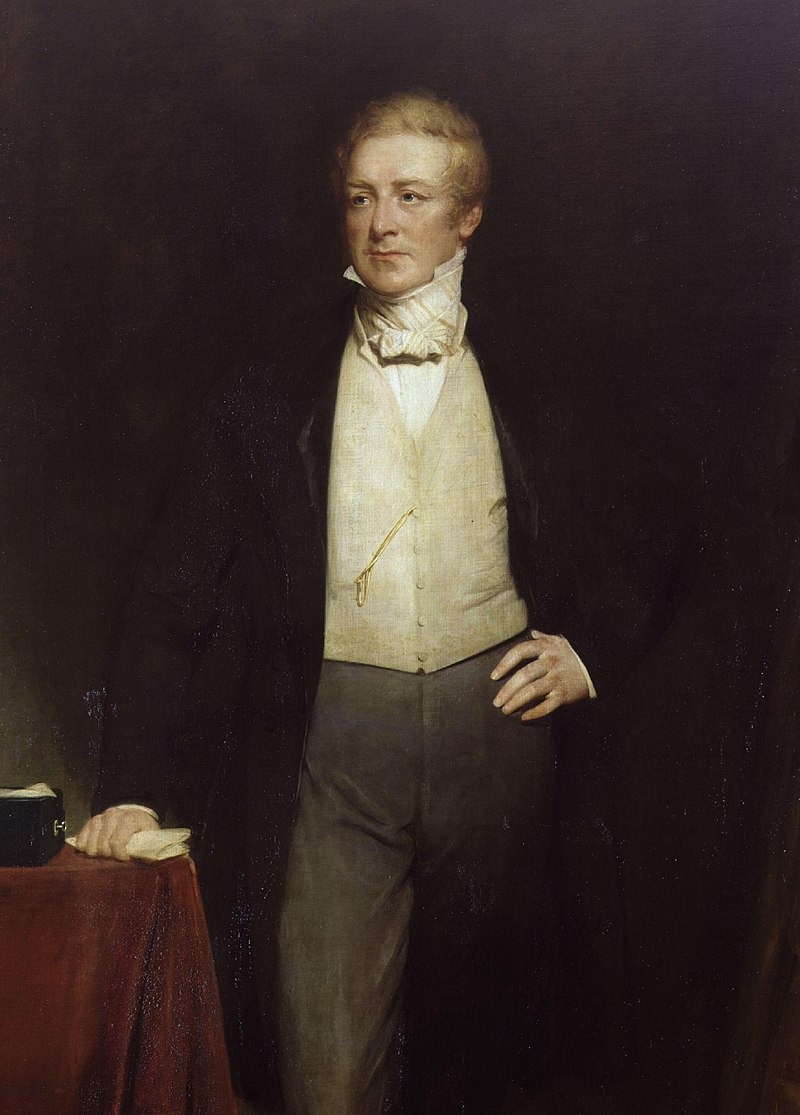
Health and Morals of Apprentices Act 1802
- Introduced by Sir Robert Peel
- Primarily aimed at improving conditions for apprentices working in cotton mills
- Strict guidelines were required for mills and industries that hired three or more apprentices. The workplace needed to be cleaned at least twice a year, have enough ventilation, and provide 12 hours of work every day
- During the first four years of their apprenticeship, apprentices had to receive reading, writing and maths training in addition to monthly church visits and religious teaching. Additionally, they had to sleep in separate beds and no more than two at a time.
Cotton Mills and Factories Act 1819
- Introduced by Sir Robert Peel and spurred by the social reformer Robert Owen
- It sought to limit the hours worked by children
- Children under 9 were prohibited from employment, while those between the ages of 9 and 16 were only allowed to work 12 hours a day in textile mills and industries under the Act. The Act only applied to children working in factories and cotton mills.
- In December 1819, an amended Act was issued that let those who had lost their jobs work at night in undamaged works until the disaster was repaired.
Cotton Mills Regulation Act 1825
- Introduced by John Cam Hobhouse
- Adhered to the initial purpose of restricting child labour and ensuring safer working conditions, but with more specific terms
- It placed a 12-hour daily cap on the amount of time children between the ages of 14 and 16 could work in cotton mills. It also mandated that children could not work between 8.30pm and 5.30am, effectively prohibiting night work for them.
Cotton Mills Act 1831
- It repealed previous Acts and consolidated provisions into a single Act
- It introduced additional restrictions, including night working for under-21s and proof of employment for mill owners
- The Act initially covered all textile mills, but then only applied to cotton mills
Factory Act 1833
- Considered a major milestone in the history of the Factory Acts, this groundbreaking legislation sought to drastically improve working conditions, particularly for children, in the textile industry
- Under this law, children under the age of nine were not allowed to be employed in the factories. Those between the ages of 9 and 13 were restricted to 8 hours of work per day, while young adults between 14 and 18 were allowed a maximum of 12 hours. It also required factory owners to pay for half-time education for any employed children, ensuring they received at least some schooling.
- The Act's creation of a system of factory inspectors was a significant advancement. Four inspectors were initially appointed to enforce the Act, and they had the power to fine those who broke the law. This provision was a key improvement on previous acts, which struggled with enforceability.
Factories Act 1844
- It was driven by concerns over health and safety conditions in the factories as well as the exploitation of child labour
- Among major provisions, the Act reduced the working hours for children aged 9 from 13 to a maximum of 6.5 hours per day
- It also increased the minimum working age to 9 and mandated that children aged 9 to 13 receive 3 hours of education per week.
- The Act introduced specific safety measures, which included secure fencing around dangerous machinery. It also provided for cleanliness and ventilation in factories. It forbade children and women to clean mill machinery while it was operating.
Factories Act 1847
- Also known as the Ten Hours Act
- Passed by Lord Ashley and John Fielden
- Demands for a shorter workday from the general public were the main driving force behind this
- It limited the workday for women and children aged 13 to 18 to 10 hours, setting a precedent for later legislation. Inspectors were employed to enforce the law, and penalties were established for factories violating the Act's provisions.
Factories Act 1856
- To keep an eye on industrial laws, the National Association of Factory Occupiers (later referred to as the National Association for the Protection of the Right to Mangle Operatives) was established in April 1855.
- The 1844 Act required secure fencing of 'mill gearing', including power shafts, but it was inconsistent in its application in areas not readily accessible.
- In 1856, the Association of Factory Occupiers therefore obtained an Act reversing this decision, stating that secure fencing only needed parts with which women, young people and children were liable to come into contact.
Factories Act 1860
- The Act specified the hours in which the 10 hours of work could be completed
- It allowed for work to be conducted from 6am and to 6pm, with an interval of 1.5 hours for meals. This effectively limited the working hours to 10.5 effective hours. The workday would end at 2pm on Saturday.
Factories Act Extension 1867
- Also called the Workshops' Regulations Act
- The Act expanded the application of the Factories Act to any businesses with 50 or more employees. Shipbuilding was one of the sectors that the Factory Acts had not previously covered.
- It brought 'workshops' (those workplaces with fewer than 50 employees) under the regulatory legislation by subjecting them to the Hours of Labour Regulation Act. This Act featured regulations comparable to those for larger factories.
Factory and Workshop Act 1878
- Also called the Consolidation Act
- It amalgamated several previous pieces of factory-related legislation to create one comprehensive law
- The Act gave individuals a 12-hour workday, with 4.5-hour workdays and food breaks in between. From the age of 5 to 14, children had to attend school, and employment was contingent on both academic success and satisfactory attendance.
Factory and Workshop Act 1891
- Two significant additions to previous legislation were made under the heading Conditions of Employment.
- The first addition prohibited employers from hiring women within four weeks of childbirth.
- The second addition raised the minimum age at which a child can be set to work from 10 to 11.
Factory and Workshop Act 1901
- This Act raised the minimum working age to 12 years old.
- It also brought up laws pertaining to mealtimes, fire escapes and children's education.
- At 13 years old, children were also allowed to start a full-time job.
Factory and Workshop Act 1937
- This consolidated the Factory and Workshop Acts of 1901–1929.
- It was introduced by Home Secretary Sir John Simon on 29 January and granted by the monarch on 30 July.
Factories Act 1959
- This Act added further health, safety and welfare measures for industry workers.
- It also amended the earlier Acts of 1937 and 1948.
Factories Act 1961
- This was the last in a series of laws under the Factory Acts, which were first introduced in 1802 and combined various occupational health, safety and welfare regulations
- The Act required all machinery with potentially dangerous components to be guarded. However, prior Acts' judicial rulings had limited the definition of 'dangerous' to only those risks that were reasonably foreseeable.
- The Health and Safety at Work, etc. Act 1974 and its regulations from 2008, however, largely replaced the Factories Act. Nonetheless, the Act remains significant due to its long-term workplace exposure to hazards such as carcinogens or industrial noise, which frequently precedes modern legislation.
IMPACT OF THE ACTS
- The Factory Acts, implemented throughout the 19th and early 20th centuries, had a significant impact on improving working conditions in Britain. The Acts led to drastic improvements such as cleaner and safer working environments, reduced working hours and better treatment of workers.
- The Acts specifically targeted the protection of vulnerable populations, including women and children. They established age restrictions for work and mandated breaks and meal times. Moreover, it increased education by requiring employers to provide half-time education for child labourers. The Acts indirectly promoted literacy and boosted basic education levels among the working class.
- Additionally, the Factory Acts led to the creation of regulatory bodies and system inspectors, a major step towards independent oversight of working conditions in factories. They set a precedent for future legislation on labour and demonstrated the role of the state in regulating labour rights and conditions.
- While the Acts were protective in nature, they had economic implications. Initially, there was resistance from mill owners due to cost implications. However, over the long term, the Acts contributed to a healthier and better-educated workforce, which had positive effects on industrial productivity.
- Nonetheless, although the Acts raised awareness about the harsh realities of industrial work, leading to increased public support for labour rights, they still faced criticism for their limited scope (initially covering only certain industries) and problems regarding enforcement due to a lack of inspectors.
- In terms of child labour, it is still unclear if its elimination by textile companies improved the welfare of children. After 1835, children who continued to work in textile manufacturers put in fewer hours than they had previously, but a significant number of them left the factories.
- Until additional information regarding what happened to people who left the factories is available, it is impossible to assess how the Factory Acts affected the welfare of children. It is possible that the youngsters simply shifted jobs, maybe to more demanding ones, given the poverty of the families whose children worked. Yet, this would not have necessarily enhanced their welfare. The idea that the early Factory Acts merely encouraged kids to find other employment is predicated on the idea that parents saw children as sources of revenue.
Frequently Asked Questions
- What are the Factory Acts in the UK?
The Factory Acts are a series of laws enacted to regulate industrial employment conditions and ensure workers' welfare in factories in the UK.
- When were the Factory Acts first introduced?
The Factory Acts were first introduced in the early 19th century, with the initial legislation, the Health and Morals of Apprentices Act 1802, followed by subsequent acts addressing broader issues in factory working conditions.
- How did the Factory Acts evolve over time?
The Factory Acts evolved to cover a wider range of workers, industries, and issues. Amendments addressed concerns related to child labour, working hours, and workplace safety.
